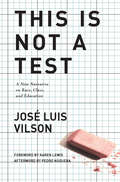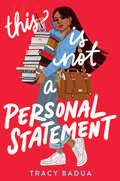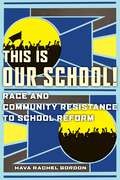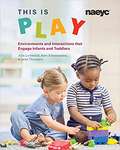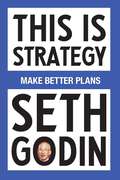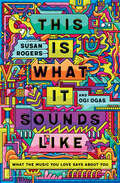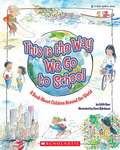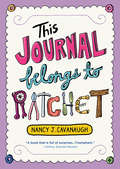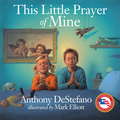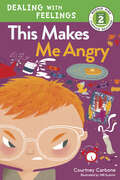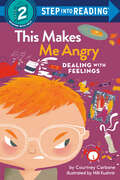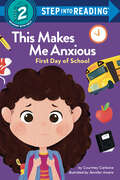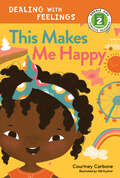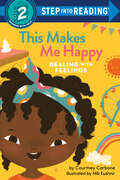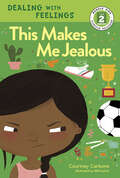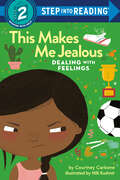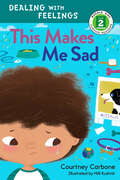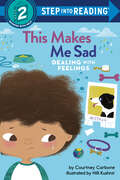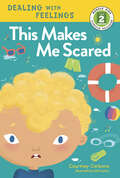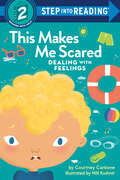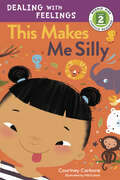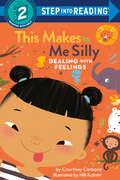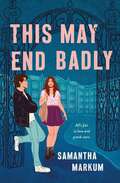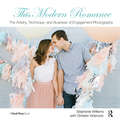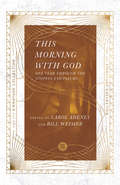- Table View
- List View
This Is Not A Test
by Karen Lewis José VilsonJosé Vilson writes about race, class, and education through stories from the classroom and researched essays. His rise from rookie math teacher to prominent teacher leader takes a twist when he takes on education reform through his now-blocked eponymous blog, TheJoseVilson.com. He calls for the reclaiming of the education profession while seeking social justice.José Vilson is a middle school math educator for in the Inwood/Washington Heights neighborhood of New York City. He writes for Edutopia, GOOD, and TransformED / Future of Teaching, and his work has appeared in Education Week, CNN.com, Huffington Post, and El Diario / La Prensa.
This Is Not a Personal Statement
by Tracy BaduaAdmission meets American Panda in this propulsive, poignant YA contemporary novel about a teen who, after getting rejected from her dream college, forges her own acceptance and commits to living a lie. Perfect for fans of Mary H.K. Choi! At sixteen, Perla is the youngest graduating senior of the hypercompetitive Monte Verde High. Praised—and not-so-quietly bashed—as “Perfect Perlie Perez,” Perla knows all the late nights, social isolation, and crushing stress will be worth it when she gets into the college of her (and her parents’) dreams: Delmont University. Then Perla doesn’t get in, and her meticulously planned future shatters. In a panic, she forges her own acceptance letter, and next thing she knows, she’s heading to Delmont for real, acceptance or not. Soon, Perla is breaking into dorm rooms, crashing classes, and dodging questions from new friends about her lack of a student ID. Her plan? Gather on-the-ground intel to beef up her application and reapply spring semester before she’s caught. But as her guilty conscience grows and campus security looms large, Perla starts to wonder if her plan will really succeed—and if this dream she’s worked for her entire life is something she even wants. From rising star Tracy Badua comes a gripping, incisive tale of acceptance, self-discovery, and the infinite possibilities that await when we embrace our imperfections.
This Is Our School!: Race and Community Resistance to School Reform
by Hava Rachel GordonHow local educational justice movements wrestle with neoliberal school reformParents, educators, and activists are passionately fighting to improve public schools around the country. In This Is Our School! Hava Rachel Gordon takes us inside these fascinating school reform movements, exploring their origins, aims, and victories as they work to build a better future for our education system.Focusing on a school district in Denver, Colorado, Gordon takes a look at different coalitions within the school reform movement, as well as the surprising competition that arises between them. Drawing on over eighty interviews and ethnographic research, she explores how these groups vie for power, as well as the role that race, class, and gentrification play in shaping their successes and failures, strategies and structures. Gordon shows us what happens when people mobilizefrom the ground up and advocate for educational change. This Is Our School! gives us an inside look at the diverse voices within the school reform movement, each of which plays an important role in the fight to improve public education.
This Is Play: Environments And Interactions That Engage Infants And Toddlers
by Janet Thompson Julia Luckenbill Aarti SubramaniamSlow down, tune in, and discover the very purposeful play of infants and toddlers. Addressing considerations like choosing interesting materials, setting up safe and inviting environments, and why you are the most important element of play for very young children, the authors come alongside to help you Better understand what play means for infants and toddlers Read children’s cues and respond to their needs for more challenge, a break from interaction, or a play partner Support children’s physical, social and emotional, language, and cognitive development Adapt the way you play with children and what materials you offer based on individual abilities, interests, and needs Look at toddler behavior in new ways and use proven strategies to help children navigate play situations with peers This book is a delightful, easy read, full of insights like how to provide play choices for even very young children and why sportscasting is not just for TV but for infant and toddler classrooms, too. With its spot-on ideas and delightful anecdotes, you’ll gain a new appreciation for infants’ and toddlers’ competence and curiosity and how important your role is in the birth-to-3 adventure. This is play for very young children and for you. Come and explore.
This Is Strategy: Make Better Plans (Create a Strategy to Elevate Your Career, Community & Life)
by Seth GodinA Best Non-Fiction Book of 2024 from The Next Big Idea Book Club and National Bestseller. From Seth Godin, one of the world's most influential business thinkers and bestselling author of This is Marketing, comes an essential guide to thinking strategically in a complex, ever-changing world."With his signature clarity and brevity, the marketing maven presents memorable, practical advice for making smarter plans." —Adam Grant, author of Think Again In this unique and thought-provoking book, Godin shares insights on strategy through a series of powerful reflections and observations that will reshape how you approach problems, make decisions, and create change. &“Creating tomorrow by repeating yesterday is not a useful way forward.&” &“Every strategy requires choice. And those choices often involve saying &‘no&’ to things we could do, but won&’t do.&” &“It&’s not easy to persuade someone to want what you want. It&’s much more productive to find people who already want to go where you&’d like to take them.&” This is Strategy is a modern classic that offers perspectives you'll find yourself returning to again and again. Rather than providing step-by-step formulas, Godin offers something more valuable: a new way of seeing and thinking about the challenges you face. You&’ll discover how to: - Identify your "smallest viable audience" and make remarkable work they can't ignore - Understand and influence the systems shaping our world - Prioritize long-term thinking over instant gratification - Make smart, purposeful choices that shape a better tomorrow Who this book is for: - Leaders who want to think more deeply about their impact - Entrepreneurs tired of conventional business advice - Change-makers seeking lasting transformation in their career and community - Anyone feeling stuck in outdated systems and looking for a fresh perspective Strategy turns our effort into impact. Your journey to better thinking starts here.
This Is What It Sounds Like: What the Music You Love Says About You
by Ogi Ogas Susan RogersNamed one of the Most Anticipated Books of 2022 by Boston Globe and Literary Hub A legendary record producer–turned–brain scientist explains why you fall in love with music. This Is What It Sounds Like is a journey into the science and soul of music that reveals the secrets of why your favorite songs move you. But it’s also a story of a musical trailblazer who began as a humble audio tech in Los Angeles, rose to become Prince’s chief engineer for Purple Rain, and then created other No. 1 hits ,including Barenaked Ladies' "One Week," as one of the most successful female record producers of all time. Now an award-winning professor of cognitive neuroscience, Susan Rogers leads readers to musical self-awareness. She explains that we each possess a unique “listener profile” based on our brain’s natural response to seven key dimensions of any song. Are you someone who prefers lyrics or melody? Do you like music “above the neck” (intellectually stimulating), or “below the neck” (instinctual and rhythmic)? Whether your taste is esoteric or mainstream, Rogers guides readers to recognize their musical personality, and offers language to describe one's own unique taste. Like most of us, Rogers is not a musician, but she shows that all of us can be musical—simply by being an active, passionate listener. While exploring the science of music and the brain, Rogers also takes us behind the scenes of record-making, using her insider’s ear to illuminate the music of Prince, Frank Sinatra, Kanye West, Lana Del Rey, and many others. She shares records that changed her life, contrasts them with those that appeal to her coauthor and students, and encourages you to think about the records that define your own identity. Told in a lively and inclusive style, This Is What It Sounds Like will refresh your playlists, deepen your connection to your favorite artists, and change the way you listen to music.
This Is the Way We Go to School: A Book about Children around the World
by Edith BaerThis book shows how much fun getting to school can be for children around the world. Filled with silly rhymes and hilarious illustrations, this book will inspire children as it teaches them that school is a wonderful and exciting place to be.
This Journal Belongs to Ratchet
by Nancy Cavanaugh"A book that is full of surprises ...Triumphant enough to make readers cheer; touching enough to make them cry."--Kirkus, STARRED Review If only getting a new life were as easy as getting a new notebook. But it's not. It's the first day of school for all the kids in the neighborhood. But not for me. I'm homeschooled. That means nothing new. No new book bag, no new clothes, and no friends - old or new. The best I've got is this notebook. I'm supposed to use it for my writing assignments, but my dad never checks. Here's what I'm really going to use it for: Ratchet's Top Secret Plan Project Goal: turn my old, recycled, freakish, friendless, motherless life into something shiny and new. This year, I'm going make something change. "One of the freshest new voices I've heard in a while...A book for young readers to enjoy, discuss, then read all over again, this debut novel is a winner."--Augusta Scattergood, Author of GLORY BE, an Amazon Best Middle Grade Novel of 2012
This Little Prayer of Mine
by Mark Elliott Anthony DestefanoNothing Compares to Childlike Faith I know you're up in heaven, God, and can hear my voice from there. I'm just a little child. Will you answer my short prayer?So begins this delightful book that affirms God's readiness to answer our prayers, no matter what our age. With engaging rhymes and beautiful illustrations, This Little Prayer of Mine assures children that God is always near--watching, listening, caring, and eager to respond to their requests. They'll also learn that prayer isn't just about asking for things, but about sharing their feelings of sadness and uncertainty as well as of thanksgiving and joy.Most importanly, This Little Prayer of Mine reminds children--and those who love them--that they can trust God to tenderly care for them, no matter what the future holds.From the Hardcover edition.
This Makes Me Angry (Rodale Kids Curious Readers/Level 2 #3)
by Courtney CarboneIn This Makes Me Angry, a young boy is not having a good day. And between the sopping wet towels in the bathroom and his homework that's been colored all over in crayon, he knows just whom to blame: his little brother, Jack. The boy's day only gets worse when he leaves Jack and goes to school. Thankfully, his principal knows exactly what will help. By drawing events of the day, the boy is able to slow down and reflect on what made him mad--so that when he returns home, his messy, crayon-covered little brother no longer seems so bad.The Dealing with Feelings series of early readers are designed to give voice to what’s brewing inside. Through short, simple text and repetitive observational phrases, the child will learn to name their emotions as they also learn to read.
This Makes Me Angry: Dealing With Feelings (Step into Reading)
by Courtney CarboneIn This Makes Me Angry, a young boy is not having a good day. And between the sopping wet towels in the bathroom and his homework that's been colored all over in crayon, he knows just whom to blame: his little brother, Jack. The boy's day only gets worse when he leaves Jack and goes to school. Thankfully, his principal knows exactly what will help. By drawing events of the day, the boy is able to slow down and reflect on what made him mad--so that when he returns home, his messy, crayon-covered little brother no longer seems so bad.The Dealing with Feelings series of early readers are designed to give voice to what’s brewing inside. Through short, simple text and repetitive observational phrases, the child will learn to name their emotions as they also learn to read.
This Makes Me Anxious: First Day of School (Step into Reading)
by Courtney CarboneGet ready to conquer those back-to-school jitters with this exciting new Dealing with Feelings beginner book! This Step 2 reader is perfect for kids who recognize familiar sight words and are working on sounding out new ones!It's natural for children to feel anxious about the first day of school, just like the kid in this story. Her chest feels as tight as her old sneakers since there is so much to do to prepare. Good thing she is not alone! Many people are there to help her feel more comfortable so she can have the best first day! Learning how to voice your feelings and count on others, like your family and teachers is an important skill that can help all children.The Dealing with Feelings series of early readers is designed to give voice to what's brewing inside. Through short, simple text and repetitive observational phrases, children will learn to name their emotions as they learn to read!Step 2 Readers use basic vocabulary and short sentences to tell simple stories, for children who recognize familiar words and can sound out new words with help.
This Makes Me Happy: Dealing with Feelings (Rodale Kids Curious Readers/Level 2 #1)
by Courtney CarboneThis Makes Me Happy follows a young girl on a field trip to the fair, complete with a roller coaster, pie-eating contest, and petting zoo! But when her pesky nut allergy keeps her from having a treat with her class, the girl learns that even the happiest of days can have unhappy moments. By reflecting on her trip and recognizing the many feelings that arose during it, she is able to feel less overwhelmed—and more confident about her positively happy day.While children enjoy expressing themselves—be it through laughter or tears—they don’t always have the words to articulate their emotions. The Dealing with Feelings series is designed to give voice to what’s brewing inside, showing children how to name their emotions as they also learn to read.
This Makes Me Happy: Dealing with Feelings (Step into Reading)
by Courtney CarboneThis Makes Me Happy follows a young girl on a field trip to the fair, complete with a roller coaster, pie-eating contest, and petting zoo! But when her pesky nut allergy keeps her from having a treat with her class, the girl learns that even the happiest of days can have unhappy moments. By reflecting on her trip and recognizing the many feelings that arose during it, she is able to feel less overwhelmed—and more confident about her positively happy day.While children enjoy expressing themselves—be it through laughter or tears—they don’t always have the words to articulate their emotions. The Dealing with Feelings series is designed to give voice to what’s brewing inside, showing children how to name their emotions as they also learn to read. Colorful stickers are included in each book.
This Makes Me Jealous: Dealing with Feelings (Rodale Kids Curious Readers/Level 2 #6)
by Courtney CarboneThe Dealing with Feelings series returns to help kids battle the green-eyed monster—jealousy! In This Makes Me Jealous, a young girl is proud of being the star athlete at her school. But when a new kid moves to town and she suddenly has to share the spotlight, jealousy gets the best of her. After a tough soccer matchup, the girl's gym teacher helps her to empathize with the new student, and give her a chance. Soon, the girl learns that making new friends and being inclusive is more important than being the best.The Dealing with Feelings series of early readers is designed to give voice to what's brewing inside. Through short, simple text and repetitive observational phrases, children will learn to name their emotions as they learn to read.
This Makes Me Jealous: Dealing with Feelings (Step into Reading)
by Courtney CarboneThe Dealing with Feelings series returns to help kids battle the green-eyed monster—jealousy! In This Makes Me Jealous, a young girl is proud of being the star athlete at her school. But when a new kid moves to town and she suddenly has to share the spotlight, jealousy gets the best of her. After a tough soccer matchup, the girl's gym teacher helps her to empathize with the new student and give her a chance. Soon, the girl learns that making new friends and being inclusive are more important than being the best.The Dealing with Feelings series of early readers is designed to give voice to what's brewing inside. Through short, simple text and repetitive observational phrases, children will learn to name their emotions as they learn to read.
This Makes Me Sad: Dealing with Feelings (Rodale Kids Curious Readers/Level 2 #2)
by Courtney CarboneIf feeling blue isn’t bad enough, it’s even worse without your best furry friend. This Makes Me Sad follows a young boy after he accidentally lets his dog, Kit, loose from the yard. Despite his parents’ attempt to find her, nothing can cheer up the boy. His favorite things, like a pretty sunset, going to the park, and his beloved teddy bear, just make him more sad. Even happy memories of Kit no longer feel good. With help from his family, the boy must learn to accept and express how he’s feeling inside. And by dealing with his feelings, he might just be able to do some good until Kit comes home. Easy-to-read text and evocative illustrations make this relatable second story in the Dealing with Feelings series a perfect practice in emotional maturity for kids, and it includes 2 sheets of colorful stickers!
This Makes Me Sad: Dealing with Feelings (Step into Reading)
by Courtney CarboneIf feeling blue isn’t bad enough, it’s even worse without your best furry friend. This Makes Me Sad follows a young boy after he accidentally lets his dog, Kit, loose from the yard. Despite his parents’ attempt to find her, nothing can cheer up the boy. His favorite things, like a pretty sunset, going to the park, and his beloved teddy bear, just make him more sad. Even happy memories of Kit no longer feel good. With help from his family, the boy must learn to accept and express how he’s feeling inside. And by dealing with his feelings, he might just be able to do some good until Kit comes home. Easy-to-read text and evocative illustrations make this relatable second story in the Dealing with Feelings series a perfect practice in emotional maturity for kids.
This Makes Me Scared: Dealing with Feelings (Rodale Kids Curious Readers/Level 2 #5)
by Courtney CarboneKids will learn it's okay to be scared—and how to confront their fears—in this installment of the Dealing with Feelings series. Paperback edition includes stickers!In This Makes Me Scared, a young boy is terrified about taking swim lessons. The water is cold, chlorine burns his eyes, and worst of all, everyone is watching him. He's scared that he'll never learn to swim--or drown trying! When his instructor shows him how to calm his mind, the boy decides to face his fear and open himself up to a fun, new experience.The Dealing with Feelings series of early readers is designed to give voice to what's brewing inside. Through short, simple text and repetitive observational phrases, children will learn to name their emotions as they learn to read.
This Makes Me Scared: Dealing with Feelings (Step into Reading)
by Courtney CarboneKids will learn it's okay to be scared—and how to confront their fears—in this installment of the Dealing with Feelings series. Paperback edition includes stickers!In This Makes Me Scared, a young boy is terrified about taking swim lessons. The water is cold, chlorine burns his eyes, and worst of all, everyone is watching him. He's scared that he'll never learn to swim--or drown trying! When his instructor shows him how to calm his mind, the boy decides to face his fear and open himself up to a fun, new experience.The Dealing with Feelings series of early readers is designed to give voice to what's brewing inside. Through short, simple text and repetitive observational phrases, children will learn to name their emotions as they learn to read.
This Makes Me Silly (Rodale Kids Curious Readers/Level 2 #4)
by Courtney CarboneIn This Makes Me Silly, a little girl and her brother go with their family to the zoo, only to find that they can't stop laughing! Between making funny monkey faces and stretching their arms for elephant trunks, it's no wonder they snort out their milk at lunch. The little girl doesn't see any harm in her silliness at first, but when she scares an animal by shouting and banging on the glass, she learns that there's a time and place to be silly (like at the zoo playground), and a time and place to be calm (when animals are sleeping).The Dealing with Feelings series of early readers are designed to give voice to what’s brewing inside. Through short, simple text and repetitive observational phrases, the child will learn to name their emotions as they also learn to read.
This Makes Me Silly: Dealing With Feelings (Step into Reading #4)
by Courtney CarboneIn This Makes Me Silly, a little girl and her brother go with their family to the zoo, only to find that they can't stop laughing! Between making funny monkey faces and stretching their arms for elephant trunks, it's no wonder they snort out their milk at lunch. The little girl doesn't see any harm in her silliness at first, but when she scares an animal by shouting and banging on the glass, she learns that there's a time and place to be silly (like at the zoo playground), and a time and place to be calm (when animals are sleeping).The Dealing with Feelings series of early readers are designed to give voice to what’s brewing inside. Through short, simple text and repetitive observational phrases, the child will learn to name their emotions as they also learn to read.
This May End Badly
by Samantha Markum“The bitingly hilarious, heartfelt This May End Badly takes your favorite fake dating trope and adds plenty of downright delightful shenanigans that’ll have readers tearing through the pages.”—Emma Lord, New York Times bestselling author of You Have a MatchPranking mastermind Doe and her motley band of Weston girls are determined to win the century-long war against Winfield Academy before the clock ticks down on their senior year. But when their headmistress announces that The Weston School will merge with its rival the following year, their longtime feud spirals into chaos.To protect the school that has been her safe haven since her parents’ divorce, Doe puts together a plan to prove once and for all that Winfield boys and Weston girls just don’t mix, starting with a direct hit at Three, Winfield’s boy king and her nemesis. In a desperate move to win, Doe strikes a bargain with Three’s cousin, Wells: If he fake dates her to get under Three’s skin, she’ll help him get back his rightful family heirloom from Three.As the pranks escalate, so do her feelings for her fake boyfriend, and Doe spins lie after lie to keep up her end of the deal. But when a teacher long suspected of inappropriate behavior messes with a younger Weston girl, Doe has to decide what’s more important: winning a rivalry, or joining forces to protect something far more critical than a prank war legacy.This May End Badly is a story about friendship, falling in love, and crossing pretty much every line presented to you—and how to atone when you do.
This Modern Romance: The Artistry, Technique, And Business Of Engagement Photography
by Stephanie Williams Christen VidanovicLove is less confined than ever, as is our desire to capture it. Engagement photography has become an essential and valuable component of wedding photography for both your clients and your photography business. Successfully booking romantic portrait sessions and providing your couples with creative, playful, and beautiful images can mean a lasting –and lucrative- relationship. Award winning photographer Stephanie Williams shares her approach to engagement photography, including her thoughts on the psychology of shooting and directing couples, current industry trends, and the use of blogs and social media. Discover photography tips on romantic styling, workflow, and branding that will help get your engagement sessions recognized by prospective clients and industry publications. Whether you are an aspiring photographer or established professional, this book is sure to inform and inspire your next photo shoot. Read tips and testimonials from prominent wedding professionals, bloggers, editors and stylists, as well as Stephanie’s actual clients. Learn how to build your brand and get your work published. Improve or refresh your technical skill through practical lighting, equipment, and technique guidance. Diversify the way you interact with clients and style your shoots. Be inspired through gorgeous photographs.
This Morning with God: One Year Through the Gospels and Psalms (The IVP Signature Collection)
by Bill Weimer Carol AdeneyWhat is God saying to you today?andThis Morning with GodThis Morning with GodThis Morning with God
